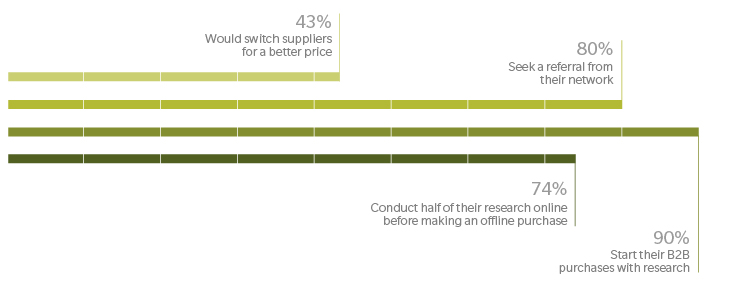A tremendous gap separates best-in-class and average players in pricing and commercial effectiveness, which means there is ample room for manufacturers to improve margins. While companies in theory know how to set correct prices, most struggle to implement the right governance systems and decision-support tools. The task is all the more difficult as the pace of decision making is likely to increase going forward. Introducing advanced analytics and other tools to support realtime decision making can lead to margin increases of between 5 and 10 percent.
Pressure To Change Pricing Methodology And Set-Up
Problems related to business-to-business (B2B) pricing are typically the result of a combination of factors. Outdated pricing systems are often based on “costplus,” and do not fully take into account the external market environment. This often makes prices less competitive in some segments and prevents the full exploitation of margin opportunities in others. Tools that do not support efficient and effective decision making are another source of problems: The tools may be able to show a variety of key performance indicators, but are not really helpful in making pricing decisions. And sometime the pricing function is weak in terms of global reach and alignment, or else it lacks the analytical and strategic capabilities needed to manage the process in a complex external environment. As a result, prices are hard to explain and justify, particularly when comparing different products, customers, geographies, and transaction types. Prices often seem to be based on gut feeling, instead of analytics and a customer’s willingness to pay.
27% of total B2B manufacturing trade will be made up by online sales in 2020.
Another force for change is online purchasing. B2B sales are today still largely conducted offline, but online sales will account for 27 percent of total B2B manufacturing trade in 2020, according to Frost & Sullivan. And already today 74 percent of buyers conduct half of their research online before making an offline purchase, according to Forrester Research. (See Exhibit below.) Sooner or later this will have a substantial impact on B2B commerce, whether players like it or not, and management will need to rethink pricing and commercial effectiveness. Setting up and properly maintaining the optimal online pricing system will soon be indispensable.
How B2B buyers purchase today

Source: Forrester Research
The growing importance of the online channel will bring with it other challenges. Companies will need to set up their commercial function, including pricing, for a multi- or omni-channel environment. Just managing prices via direct orders – phone, email, or personal visits – or in an online shop will no longer be sufficient to compete. Online marketplaces are also growing, with online retailers expanding into B2B environments and platforms serving as aggregator or comparison sites. They will heavily influence how companies manage price points in their traditional sales channels, which have been sales agents, wholesalers, and foreign subsidiaries or affiliates.
While it is theoretically manageable to set correct price points across channels, most companies struggle to implement the correct governance systems and decision-support tools. This will remain difficult, because the pace of decision making is likely to increase. Moreover, the digital disruptors of the online retail world are certain to arrive, bringing with them very different cost structures and objectives, yet many companies have still not figured out what is the correct response, both in terms of offerings and price points.
New Wave Of Techniques
To overcome these challenges, the pricing and commercial function needs to be better equipped to deal with this more complex environment. Several levers can improve pricing as part of a sustainable, ongoing effort. First, a more analytical approach combined with an advanced pricing system can help go beyond the traditional cost-plus method. The criteria related to product, customer, and order type that drive price perception and sensitivity should be clearly identified. This can then help to replace a one-size-fits-all pricing approach in order to better target all available margin pockets. To achieve this, the pricing methodology needs to make greater use of the company’s own data and incorporate information from the outside on factors such as customers’ needs and willingness to pay.
Second, a more global approach to pricing should allow discretion at the levels of region, business unit, and sales rep. A lot of knowledge still resides with staff on the ground – for example, the competitive intensity and price levels in a particular region. Prices for similar products and customers can easily fluctuate by between 10 and 20 percent depending on a particular customer’s situation and the business objectives the company is pursuing vis-a-vis that customer. So it is important to have a degree of local input on pricing. This should be combined with a harmonized approach, including clear rules, such as price lists, discount structures, and surcharges.
A third lever is tailoring tools to meet the needs of the sales force in real time. Such tools would have simpler metrics highlighting the business evolution or potential white spots of a customer – that is, product areas where the customer’s demand is not being met. Concrete price recommendation tools would guide the sales force in setting prices. Also useful would be visibility and control tools that help track sales-rep pricing performance. If management and sales teams design these tools together, they can make them much more powerful than off-the-shelf tools: They will be user-friendly and not be perceived as an administrative burden, and will be used proactively by both the sales force and management.
Companies today are wary of raising their prices above industry inflation levels, given customer resistance to hikes in prices. But price increases may be more palatable if they are tailored to individual products and customers, and are based on strong analytics, enabling salespeople to justify the increases. Implementing new and easy-to-use tools is critical toward making price changes stick. To generate such tools, senior management must pay greater attention to pricing and invest in the necessary capabilities. The payoff can come quickly.






